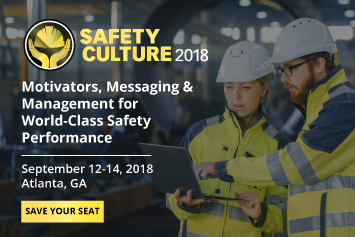Safety culture is a critical topic for EHS leaders across high risk industries right now. It’s no secret that organizations with the strongest cultures have more engaged employees, superior safety performance and most importantly, fewer workplace incidents. But when it comes to building and fostering a safety culture that sticks, many organizations still struggle.

The truth is, safety culture isn’t just providing workers with PPE, hosting toolbox talks and walking through a job site telling people what to do. Your safety culture is a branch of your company’s overarching culture that sets the tone for how employees should behave in your unique working environment. And when it comes to getting employees to embrace your safety culture, think of it as a top-down ideological shift that needs to happen across the company—starting with your executive team, all the way to your frontline workforce.
To make your culture stick, everyone must first share the same mindset and approach to safety across the company, which involves embracing the core value that safety comes first, above everything else. The most effective way to ensure employees are bought into your safety belief system is to induct them into your safety culture early—starting during day one of the onboarding process.
Safety Starts at Onboarding
Orientation and onboarding is one of the most crucial stages of the employee life cycle. The knowledge you impart upon workers during this formative window will be carried with them throughout the rest of their tenure at your company. A new worker’s first few days on the job is your greatest opportunity to familiarize them with your safety culture, shape their views and attitudes towards safety and set them up for long-term success.
While there are a number of ways to get employees invested in your safety culture, we’ve found that the most effective approach involves following the PART method, outlined below.
Using the PART Method to Strengthen Safety Culture
Participation
Ultimately, getting direct worker participation in safety activities is the most important element of an effective safety culture. What safety participation looks like will differ across organizations, but to run a best-in-class EHS program, you must ensure everyone is a part of the safety process, at every level of your organization. Encourage and ask workers to participate regularly, starting during their first onboarding session. If your new workers see company executives talking about and participating in safety, they will do it too. If they witness their peers participating in safety, they will do it too.
Affirmation
To make sure everyone’s on the same page when it comes to cultural values and beliefs, make sure your company’s executives and your EHS team are aligned and delivering a unified message that assets that the core principals around your safety culture are true and absolute. There is no room for doubt when it comes to the safety culture and if executives, employees and the safety team deliver a consistent message that leaves no room for doubt, new employees will do the same. The more this message is shared across the enterprise, the more it will resonate and the more it will encourage the right type of behavior among frontline workers.
Repetition
The power of affirmation lies in repetition. Making your culture stick starts with frequently communicating your key safety message. Everyone needs to be repeating the same message. The best message is like the flu because it’s easy to catch, easy to give and hard to shake. Try brainstorming a few short and easy safety messages that describe your culture and test them out by saying them a few times to certain people. Are those people repeating them? If they are, you might have found yourself a winning message. Take every opportunity available to engage at-risk workers in conversations about safety to drive your point across—during toolbox talks, joint health and safety committee sessions and all-hands meetings. Repeat, repeat, repeat!
Transparency
Lastly, safety performance needs to be completely transparent across the organization to drive continuous improvement. Set safety goals on a quarterly and annual basis and make sure these goals are being shared with both frontline workers and executives. When everyone is aware of goals and are working to achieve them together, it fosters a sense of community, strengthens culture and motivates everyone to contribute and participate more.
About Josh LeBrun
Josh LeBrun is president and COO of eCompliance, a leading provider of EHS management solutions designed to improve worker participation in safety. He is responsible for the company’s day-to-day operations and heads the customer success team to ensure the successful onboarding, orientation, support, and training of safety professionals throughout North America. With over 450 customers across the manufacturing, construction, utilities and energy industries, Mr. LeBrun has seen firsthand which elements shape a strong safety culture. With many years of experience in the health and safety software space, he is considered an advisor and mentor on industry trends, best practices, and is a member of the National Safety Council’s Young Professionals Division.
Follow @eCompliance for more EHS insights and safety management tips.


